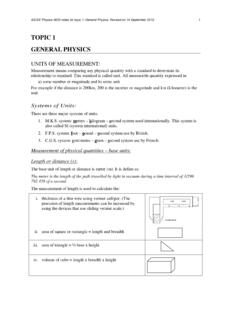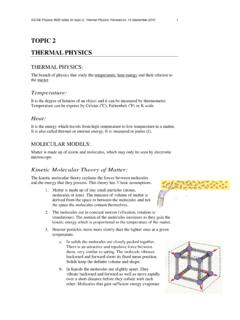Transcription of GLOSSARY OF PHYSICS TERMS - Physics Resources
1 Log on to for finding solutions to your PHYSICS problems and more GLOSSARY OF PHYSICS TERMS Absolute humidity (or Saturation value) The maximum amount of water vapor, which could be present in 1 m of the air at any given temperature, is called absolute humidity. Absolute magnitude A classification scheme, which compensates for the distance, differences to stars. It calculates the brightness that stars would appear to have if they were all at a defined, standard distance of 10 parsec Absolute scale Temperature scale set so that zero is at the theoretical lowest temperature possible. This would occur when all random motion of molecules has ceased Absolute zero The theoretical lowest temperature possible, which occurs when all random motion of molecules has ceased Acceleration due to gravity The acceleration produced in a body due to the earth's attraction is called acceleration due to gravity. It is denoted by the letter g. Its SI unit is m/s . On the surface of the earth, its average value is.
2 The value of g on the surface of the earth increases in going towards the poles from the equator. The acceleration due to gravity of the earth decreases with altitude and with depth inside the earth. The value of g at the center of the earth is zero. Acceleration The rate of change of velocity of a moving object is called its acceleration. The SI units of acceleration are m / s . By definition, this change in velocity can result from a change in speed, a change in direction, or a combination of changes in speed and direction Adiabatic cooling The decrease in temperature of an expanding gas that involves no additional heat flowing out of the gas. It is the cooling from the energy lost by expansion Adiabatic heating The increase in temperature of compressed gas that involves no additional heat flowing into the gas. It is heating from the energy gained by compression Air mass A large, more or less uniform body of air with nearly the same temperature and moisture conditions throughout Allotropic forms Elements that can have several different structures with different physical properties-for example, graphite and diamond are two allotropic forms of carbon Alpha particle The nucleus of a helium atom (two protons and two neutrons) emitted as radiation from a decaying heavy nucleus; also known as an alpha ray Alternating current An electric current that first moves one direction, then the opposite direction with a regular frequency Amp Unit of electric current.
3 It is equivalent to coulomb/sec. Ampere Full name of the unit Amp Amplitude (of waves) The maximum displacement of particles of the medium from their mean positions during the propagation of a wave is called the amplitude of the wave. Amplitude (of an oscillation) The maximum displacement of a body from its mean position during an oscillatory motion is called the amplitude of oscillation. Angle of incidence Angle of an incident (arriving) ray or particle to a surface; measured from a line perpendicular to the surface (the normal) Angle of reflection Angle of a reflected ray or particle from a surface; measured from a line perpendicular to the surface (the normal) Angular Acceleration The rate of change of angular velocity of a body moving along a circular path is called its angular acceleration. Angular acceleration is denoted by a. Angular Displacement The angle described at the center of the circle by a moving body along a circular path is called angular displacement.
4 It is measured in radians. Angular Momentum Quantum Number From quantum mechanics model of the atom, one of four descriptions of the energy state of an electron wave. The quantum number describes the energy sublevels of electrons within the main energy levels of an atom Angular Velocity The rate of change of angular displacement is called angular velocity. Astronomical unit The radius of the earth's orbit is defined as one astronomical unit ( ) Atom The smallest unit of an element that can exist alone or in combination with other elements Atomic mass unit Relative mass unit (u) of an isotope based on the standard of the carbon-12 isotope, which is defined as a mass of exactly u; one atomic mass unit (I u) is 1/12 the mass of a carbon-12 atom Atomic number The number of protons in the nucleus of an atom Atomic Weight Weighted average of the masses of stable isotopes of an element as they occur in nature, based on the abundance of each isotope of the element and the atomic mass of the isotope compared to carbon-12 Avogadro's Number The number of carbon-12 atoms in exactly g of C that is x 10^23 atoms or other chemical units.
5 It is the number of chemical units in one mole of a substance Axis The imaginary line about which a planet or other object rotates Background radiation Ionizing radiation (alpha, beta, gamma, etc.) from natural sources Balanced Forces When a number of forces act on a body, and the resultant force is zero, then the forces are said to be resultant forces. Balmer series A set of four line spectra, narrow lines of color emitted by hydrogen atom electrons as they drop from excited states to the ground state Barometer An instrument that measures atmospheric pressure, used in weather forecasting and in determining elevation above sea level Beat Rhythmic increases and decreases of volume from constructive and destructive interference between two sound waves of slightly different frequencies Beta particle High-energy electron emitted as ionizing radiation from a decaying nucleus; also known as a beta ray Big bang theory Current model of galactic evolution in which the universe was created from an intense and brilliant explosion from a primeval fireball Binding energy The energy required to break a nucleus into its constituent protons and neutrons.
6 Also the energy equivalent released when a nucleus is formed Black hole The theoretical remaining core of a supernova that is so dense that even light cannot escape Blackbody radiation Electromagnetic radiation emitted by an ideal material (the blackbody) that perfectly absorbs and perfectly emits radiation Bohr model Model of the structure of the atom that attempted to correct the deficiencies of the solar system model and account for the Balmer series Boiling point The temperature at which a phase change of liquid to gas takes place through boiling. It is the same temperature as the condensation point Boundary The division between two regions of differing physical properties British thermal unit The amount of energy or heat needed to increase the temperature of one pound of water one degree Fahrenheit (abbreviated Btu) Cathode rays Negatively charged particles (electrons) that are emitted from a negative terminal in an evacuated glass tube Celsius scale of temperature In the Celsius scale of temperature, the ice-point is taken as taken as the lower fixed point (0 deg C ) and the steam-point is taken as the upper fixed point (100 deg C).
7 The interval between the ice point and steam point is divided into 100 equal divisions. Thus, the unit division on this scale is 1degC. This scale was earlier called the centigrade scale. 1 deg C = 9/5 deg F. Centigrade Alternate name for the Celsius scale Centrifugal force An apparent outward force on an object following a circular path that. This force is a consequence of the third law of motion Centripetal force The force required to pull an object out of its natural straight-line path and into a circular path; centripetal means Chain reaction A self-sustaining reaction where some of the products are able to produce more reactions of the same kind; in a nuclear chain reaction neutrons are the products that produce more nuclear reactions in a self-sustaining series Circular Motion The motion of a body along a circular path is called circular motion. Coefficient of cubical expansion The increase in volume of a substance per unit original volume per degree rise in temperature is called its coefficient of cubical expansion.
8 The SI unit of coefficient of cubical expansion is K-1. Coefficient of linear expansion The increase in length per unit original length per degree rise in temperature is called the coefficient of linear expansion. The SI unit of the coefficient of linear expansion is K-1. Compression A part of a longitudinal wave in which the density of the particles of the medium is higher than the normal density is called a compression. Compressive stress A force that tends to compress the surface as the earth's plates move into each other Condensation (sound) A compression of gas molecules; a pulse of increased density and pressure that moves through the air at the speed of sound Condensation (water vapor) Where more vapor or gas molecules are returning to the liquid state than are evaporating Condensation nuclei Tiny particles such as tiny dust, smoke, soot, and salt crystals that are suspended in the air on which water condenses condensation point the temperature at which a gas or vapor changes back to a liquid Condensation point the temperature at which a gas or vapor changes back to a liquid Conduction The transfer of heat from a region of higher temperature to a region of lower temperature by increased kinetic energy moving from molecule to molecule Constructive interference The condition in which two waves arriving at the same place, at the same time and in phase.
9 Add amplitudes to create a new wave Control rods Rods inserted between fuel rods in a nuclear reactor to absorb neutrons and thus control the rate of the nuclear chain reaction Convection Transfer of heat from a region of higher temperature to a region of lower temperature by the displacement of high-energy molecules-for example, the displacement of warmer, less dense air (higher kinetic energy) by cooler, denser air (lower kinetic energy) Conventional current Opposite to electron current-that is, considers an electric current to consist of a drift of positive charges that flow from the positive terminal to the negative terminal of a battery Coulomb Unit used to measure quantity of electric charge; equivalent to the charge resulting from the transfer of billion particles such as the electron Coulomb's law Relationship between charge, distance, and magnitude of the electrical force between two bodies Covalent bond A chemical bond formed by the sharing of a pair of electrons Covalent compound Chemical compound held together by a covalent bond or bonds Crest The point of maximum positive displacement on a transverse wave is called a crest.
10 Critical angle Limit to the angle of incidence when all light rays are reflected internally Critical mass Mass of fissionable material needed to sustain a chain reaction Curvilinear Motion The motion of a body along a curved path is called curvilinear motion. Cycle A complete vibration De-acceleration See retardation Decibel scale A nonlinear scale of loudness based on the ratio of the intensity level of a sound to the intensity at the threshold of hearing Destructive interference The condition in which two waves arriving at the same point at the same time out of phase add amplitudes to create zero total disturbance. (also see constructive interference Dew point temperature The temperature at which condensation begins Dew Condensation of water vapor into droplets of liquid on surfaces Diffraction The bending of light around the edge of an opaque object Diffuse reflection Light rays reflected in many random directions, as opposed to the parallel rays reflected from a perfectly smooth surface such as a mirror Direct current An electrical current that always moves in one direction Direct proportion When two variables increase or decrease together in the same ratio (at the same rate) Dispersion The effect of spreading colors of light into a spectrum with a material that has an index of refraction that varies with wavelength Displacement The change in the position of an object in a particular direction is called displacement.)


